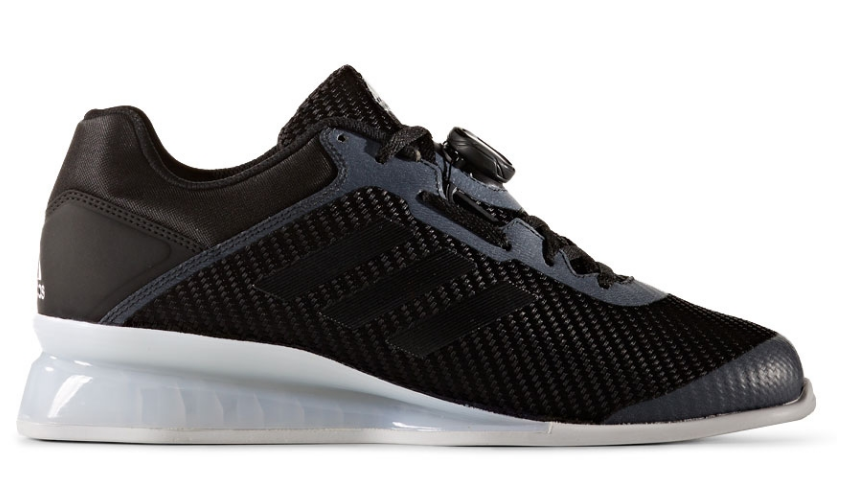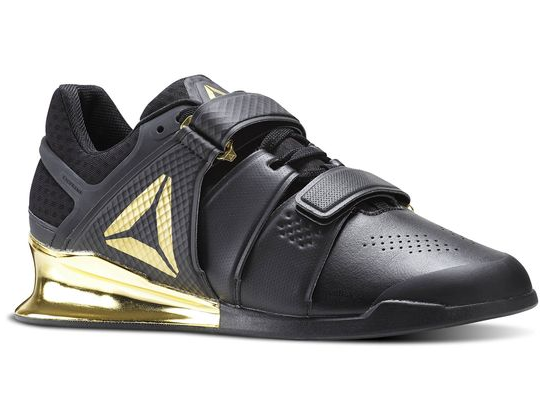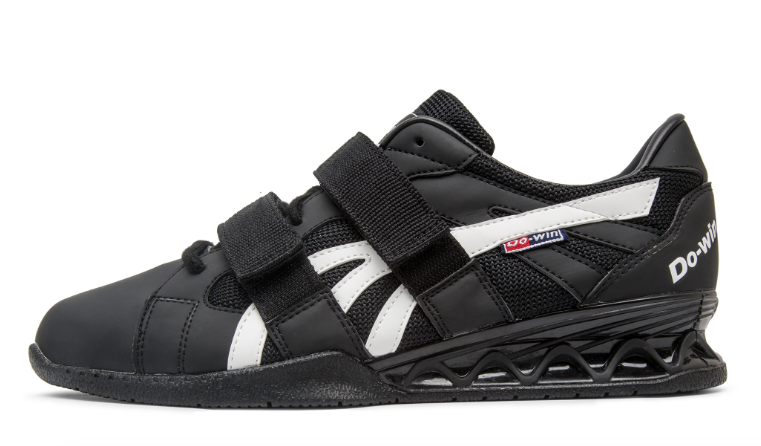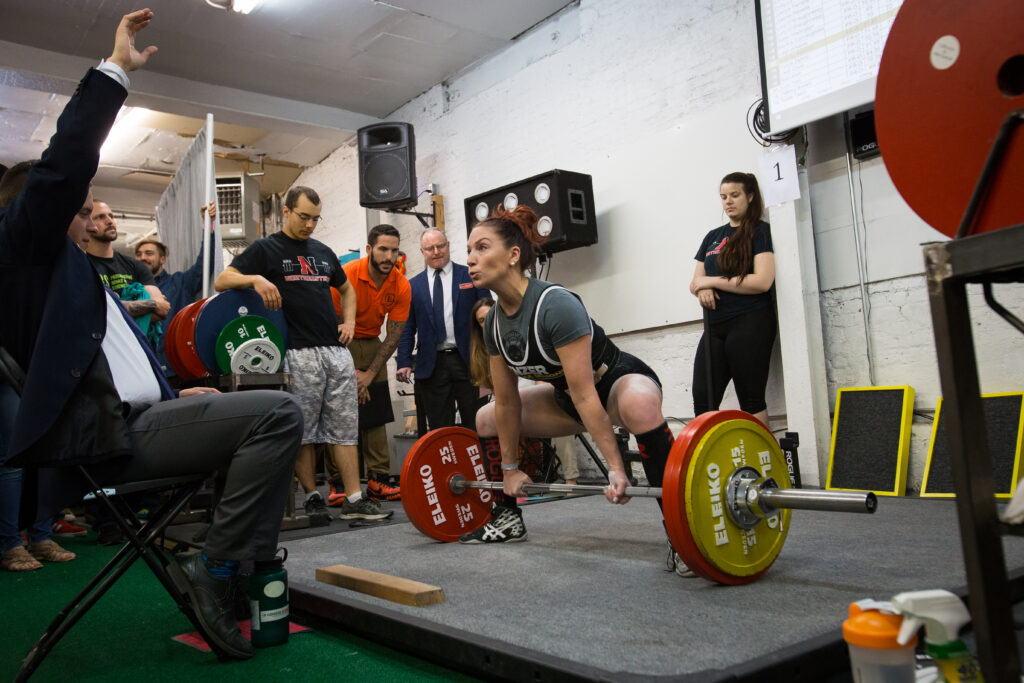Supportive strength gear has grown in popularity in the last few years, and weightlifting shoes experienced an especially big spike in visibility. There are now multiple major brands that carry and design shoes for every type of strength athlete. Every shoe comes with individual differences that make them different from similar models on the market, so it’s nearly impossible not to find a shoe that suits your needs.
An issue some athletes face when buying new shoes is the overwhelming number of choices. To assist in your shoe shopping endeavors and to provide you with a full understanding of what to look for in a shoe, we’ve made a definitive guide to lifting shoes. From the very beginning of the weightlifting shoe’s history to the different types of lacing systems, we have you covered.
[Excited to find that perfect shoe? Read our full rundown of the best lifting shoes!]
The History of Weightlifting Shoes
Lifting shoes seem to be more commonly used now than ever, but this wasn’t always the case. The demand and usage of lifting shoes can be closely linked to the history and progression of the sport of weightlifting. In 1929, the International Weightlifting Federation created formal competition to test an athlete’s press, snatch, and clean & jerk.
In the years following, athletes were documented competing in multiple styles of shoes including plain sneakers, work boots, and boxing shoes.
As the sport developed, so did different lifting styles, which was a key point to the need for an elevated heel. The 1960s were a time when split jerking was beginning to rise in popularity.
This was a game-changing method for weightlifting athletes, as it was a new way for them to descend even further under the bar. The issue that then followed was the increased shin angle and lack of stability a lifter experienced the lower they descended. Incomes the USSR who often dominated weightlifting competitions through the 60s.
They’re thought to be the first athletes to utilize a formally raised heel in a shoe. Soviet lifters nailed raised heels to their leather shoes to provide increased ankle mobility when descending under the bar. Soon after, companies such as Puma, York, Karhu, and Tiger started creating their own versions of weightlifting shoes/boots to shadow the Soviet’s design.
In the late 60s and early 70s Adidas began to pave the way for the Western lifting world. Yet, it wasn’t until weightlifting legend Tommy Kono began to collaborate with Adidas in the early 1970s that lifting shoes really began to improve.
It was at this time when they decided to cut the high top section off of shoes and move the strap down. They found this provided even more ankle mobility than the previous high top models, which is what weightlifters were most concerned with. Since this point, shoe companies continue to replicate and improve upon similar low-cut shoe models.
Benefits of Weightlifting Shoes
There are multiple benefits that come with using weightlifting shoes for workouts — and not just for Olympic weightlifters. One of the biggest reasons for their usage is the increase in ankle range of motion. The elevated heel allows a lifter to sit back more in a squat and provides their shin an increase in mobility with supported clearance. This supports a lifter’s ability to drop below weight at their lowest possible position, while keeping their foot planted and posture strong.
Another benefit is the stability these shoes provide. When squatting or performing other power based movements it’s important to create a stable base. Regular sneakers with a foam or rubber base can leave a lifter’s ankle on an unstable surface, which can become a safety issue. Also, a firm hard sole will allow a lifter to fully feel and drive through the floor beneath them. In addition, most lifting shoes have a strap, sometimes two, that provide additional support through the mid-foot and upper portion of the shoe.
Major Brands and Models
There are multiple brands and models within the weightlifting shoe world. Below is a list of some of the biggest brands and models you can expect to see when searching for a pair of new shoes. Every brand’s models will have different specs, which include varied heel height, base, amount of straps, lacing system, and custom designs.
[What brand fits and matches your needs best? Check out our weightlifting shoe quiz!]
Nike

Romaleos 2
Nike has been in the weightlifting shoe space for numerous years, but the company went on a hiatus in the early 90’s only to return around 2009. Their shoes are created with a TPU heel, have one or two straps (pending on model), and have a standard .75″ heel.

Romaleos 3
| Model | Heel | Lacing | Heel Height | Straps |
| Romaleos 2 | TPU | Regular | .75″ | 2 |
| Romaleos 3 | TPU | Regular | .75″ | 1 |
Adidas
Adidas have been in the weightlifting shoe market since 1970 and currently create models with a variety of specs. They offer shoes with a variety of heel heights including .6″, .63″, .75″, and 1″. Their Leistung models utilize the BOA lacing system.

Adidas Leistung 16 II
| Model | Heel | Lacing | Heel Height | Straps |
| Leistung | TPU | BOA Lacing | 1″ | 0 |
| Leistung 16 II | TPU | BOA Lacing | 1″ | 0 |
| Powerlift 2 | Plastic | Regular | .6″ | 1 |
| Powerlift 3 | Plastic | Regular | .6″ | 1 |
| AdiPower | TPU | Regular | .75″ | 1 |
| CrazyPower | TPU | Regular | .63″ | 1 |
NOBULL
NOBULL Lifters are gaining popularity and are relatively new to the weightlifting shoe space. They released their first model in 2016 and offer a shoe model with a stacked leather heel and .75″ lift.

NOBULL Lifters; image courtesy of @nobullproject on Instagram
| Model | Heel | Lacing | Heel Height | Straps |
| NOBULL Lifter | Stacked Leather | Regular | .75″ | 1 |
Reebok
Reebok, along with Nike and Adidas, has been in the weightlifting shoe space for a long time. They currently manufacture shoes with multiple heel heights, which vary between .6″ and .75″ lifts. In addition, Reebok offers shoes with multiple strapping styles for support of a variety of strength sports.

Reebok Legacy Lifter
| Model | Heel | Lacing | Heel Height | Straps |
| Legacy Lifter | TPU | Regular | .75″ | 2 |
| Lifter PR | TPU | Regular | .6″ | 1 |
| CrossFit Transition | EVA | Regular | .7″ | 1 |
Rogue Do-Win
The Rogue Do-Win has a standard plastic heel and comes with two straps. Their shoes are made with suede, which make them unique to most lifters. They have a .75″ heel and are designed for athletes who partake in multiple strength sports.

Rogue Do-Win
| Model | Heel | Lacing | Heel Height | Straps |
| Do-Win | Plastic | Regular | .75″ | 2 |
Inov-8
Inov-8 was founded in 2003 and offer shoes that are designed to support multiple types of strength sports. In most of Inov-8’s shoes they offer their signature PowerTruss heel support system. In addition, they offer a lower .65″ heel.

Inov-8 FastLift 725
| Model | Heel | Lacing | Heel Height | Straps |
| FastLift 325 | PowerTruss Heel | Regular | .65″ | 1 |
| FastLift 370 | PowerTruss Heel | BOA Lacing | .65″ | 0 |
Position USA
Position USA makes weightlifting shoes with an old school feel. They offer a 1″ wood heel, which makes them a desirable option for a lot of weightlifters. In terms of support, the Position USA models feature a large strap that covers the mid-foot.

Position USA Lifter; image courtesy @positionusa on Instagram
| Model | Heel | Lacing | Heel Height | Straps |
| Eastwood | Wood | Regular | 1″ | 1 |
| Redford | Wood | Regular | 1″ | 1 |
| P2.1 Blue Suede | Wood | Regular | 1″ | 1 |
As mentioned above, every brand’s model will contain different specs to create the best weightlifting shoe for you. Below is more in-depth descriptions of a shoe’s common features.
The Best Weightlifting Shoe
It’s hard to say which weightlifting shoe is the absolute best, as every lifter will have different preferences. This is what makes knowing your body, strength sport, and different types of shoe designs so important. There are multiple factors that create the best weightlifting shoe for you, so we broke them down in the sections below. They include a lifting shoe’s heel height, strap system, heel type, and lacing system, which all very between shoe models.
Below is a list of criteria you can ask yourself before making your next weightlifting shoe purchase.
- How important is stability to you?
- How much security do you want in your shoe?
- How high of a heel do you need and prefer?
- What type of heel would you like?
- What type of lifting do you perform most often?
[To expand on the above questions, take our weightlifting shoe quiz!]
The quiz linked above is designed to match you with your ideal lifting shoe based on your preferential needs and strength sport. This quiz isn’t a definitive answer, but it can be a great starting point for finding the pair of lifting shoes that fit your needs best.
Differences in Weightlifting Shoe Heel Height
A consideration every lifter should think about when purchasing lifting shoes is their desired heel height. This is a big factor for most lifters because it will help optimize an athlete’s comfort through the variety of movements they’re buying the shoes for. The standard heel on lifting shoes is .75″, but there are some models that feature a 1″ heel like the Adidas Leistung and then lower .6″ heels like the Adidas PowerLift 3.
Anthropometrics and strength sport will also play a large role in the heel height you should be using. For taller athletes, often a higher heel may be a better choice due to longer lower extremities. Below is a chart that can help you decide on a heel height based on your shin and femur length.
A taller heel allows an athlete to achieve more range of motion at the ankle. A lower heel is beneficial for shorter limbs and athletes who choose to low-bar squat, as this squat style utilizes more hip hinge and relies less on ankle mobility.
Often the .75″ heel is the best choice for a wide variety of athletes and sports. If you’re in question, then check out the chart above that may provide some insights to your squat style and shoe demands.
Straps and Security
Another shoe characteristic athletes can consider when purchasing a lifter is the amount of straps a shoe has. Most shoes have one strap, but some come with two like the Reebok Legacy Lifter. The most common place you’ll find a strap is around the upper part of the tongue. This is designed to provide extra security for the increased ankle mobility in the squat.
Some models feature lower or mid-foot straps like the Position USA Eastwood shoe, which cover the middle portion of the tongue. If security is a big concern for you, then you’ll most likely be best suited with a shoe that offers two straps or thicker strap like Position USA’s models. Yet, single strap models provide ample security as well, so it really comes down to personal preference.
Plastic, Leather, and Wood Heels
Weightlifting shoes have different types of heels that lifters can choose from judging on their personal preference. Plastic heels, often a TPU material, are the most common base used in lifting shoes. These plastic based heels provide a hard surface to stand on and they’re generally more durable than wood or leather soles. They also come in multiple variations in the ways they’re constructed, such as solid blocks and pillars.
Wood heels are for the weightlifters who want a more old school shoe with a solid base. This sole is said to allow lifters to feel the floor better and is most commonly used by Olympic weightlifting athletes. The Position USA shoes use a wood heel. Leather heels are similar to wood and provide the old school look.
The NOBULL Lifter is one of the few shoes on the market that use the stacked leather heel design. One issue lifters may run into with leather and wood heels is their durability over a long duration of time.
Lacing Systems
Generally lifting shoes come with standard shoe laces like you’d find in other shoes. The laces you find in them are similar to tennis shoes or crosstrainers you’d buy, but can always be switched out.
Lifting shoes that use a different tightening system include the Adidas Leistungs and Inov-8 FastLift 370 models. These shoes have what’s called a BOA lacing system and involves a dial to produce full shoe tightness. Issues with this type of lacing system revolve around the shoe’s ability to maintain constant maximal tightness.
Best Lifting Shoes for Squats
One of the biggest reasons strength athletes use weightlifting shoes is for their support in the squat. Whether you’re a weightlifter, powerlifter, strongman athlete, CrossFit athlete, or bodybuilder, then squats are most likely essential to your training success. Weightlifting shoes provide a firm and hard base for a lifter to sit back on and drive through the floor with.
The elevated heel provides a lifter with the ability to achieve full-depth with comfort and mobility support. This can be increasingly more important for athletes who need to catch a bar in the bottom of their squat. A strong stable shoe can help prevent a lifter’s knees caving in.
One study from 2012 compared athlete’s squats in weightlifting shoes and running shoes. Authors found that those who wore the weightlifting shoe had higher quad activation and less forward lean. In addition, the authors pointed out that there was less flexion in the lumbar, which is seen when forward lean is present.
Whether you squat low-bar or high-bar, then lifting shoes can provide your squat some benefit. They can be a great tool for newer squatters who have to work on their mechanics and mobility. As lifter’s progress in their career, they may begin to squat without lifters more, as their mechanics, needs, and understanding of the squat improve. For beginning lifters, the use of lifting shoes can be a great tool to help teach squat mechanics.
Best Lifting Shoes for Deadlifts
Deadlifts in lifting shoes will come down to a lifter’s personal preferences. Some athletes prefer to lift in shoes with lower heels. An increased heel can increase the range of motion a lifter has to pull weight, and this is why a lot of lifters veer away from lifting on a platformed shoe.

Out of every strength athlete, weightlifters will be most prone to perform deadlift style pulls in lifting shoes, as they most closely shadow competition lifts, setups, and postures. For example, when a weightlifter sets for Olympic lifts and things like clean pulls, then they’ll want a similar feel and setup for ever rep. Powerlifters may want to avoid pulling in an elevated heel. The elevation can shift them forward, which is something that can cause the loss of power by lack of balance, loose body tightness, and poor grounding of the feet.
For athletes who enjoy the extra ankle stability and rigid surface to pull off of, then they may want to opt for lower heeled options. For example, the Adidas Powerlift 3 offers a .6″ heel, which might not bother some lifters. The best lifting shoes for deadlifts will be dependent on an athlete’s preferences and sport. Whatever shoe most closely replicates an athlete’s competition movements or lifting style will be their best bet.
Best Lifting Shoes for Powerlifting
The best lifting shoes for powerlifting will often come down to an athlete’s squat style, anthropometrics, and preferences. A low-bar squat will require more hip hinge and in many cases, will be easier to be performed with a lower heel. High-bar squatters might find they like a higher heel, as it helps them maintain a more upright posture.
Anthropometrics can also help a powerlifter determine which lifting shoe is best for them. Longer lower-extremities will typically need a higher heel to support strong postures throughout lifts. Shorter athletes with often find smaller heels benefit them best because it allows them to hit depth and maintain a strong rigid torso posture.

A shoe’s security can also influence a powerlifter’s shoe decision. Two straps will provide a lifter to pull a shoe tighter. Also, a strap positioned higher by the tongue will better support the ankle’s range of motion.
Best Lifting Shoes for CrossFit®-Style Training
Shoes designed to support CrossFit®-style training will have multiple characteristics that can enhance an athlete’s performance. These shoes will often have a low-medium level heel. Since these workouts often require athletes to perform Olympic and powerlifting style movements in one workout, then versatility can be an important factor. Higher heels often correlate to greater offsets (higher slope from heel to toe), which can be an issue for lifters who need a flatter shoe in multiple movements
In addition, a shoe’s security can play an important role. As an athlete moves from movement to movement, then they’ll need a shoe that stays secure. Single strap options that cover the mid-foot may be preferential for this style athlete because it promotes a mid-foot shoe tightness. On the flip side, two strap shoes can also be preferential in providing full shoe security.
Wrapping Up
Weightlifting shoes have had a long history of development and growth. They initially grew in popularity due to the sport of weightlifting, but have since become useful to every strength sport. With so many brands and models, it’s nearly impossible for an athlete to not find their perfect weightlifting shoe.
Consider your individual preferences and the different specs that make a brand’s model unique. Things like heel height, security, and heel surface are all factors that can influence and enhance your lifting.